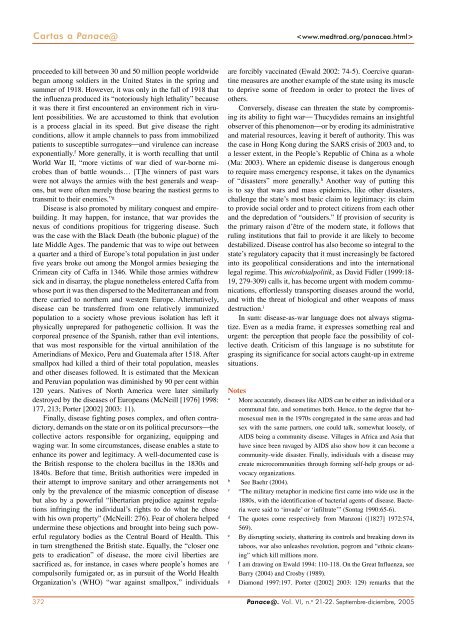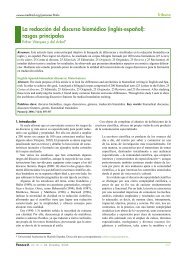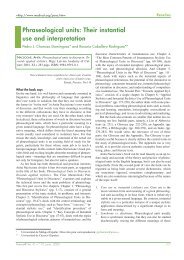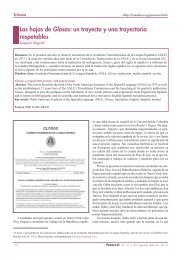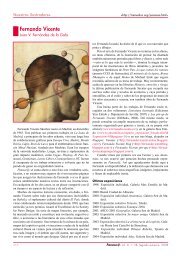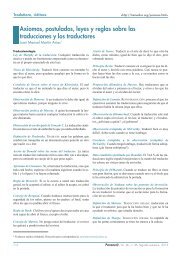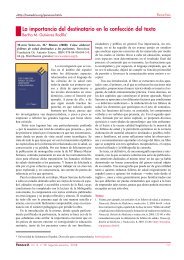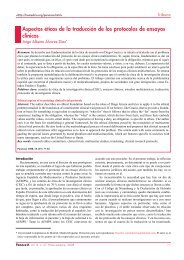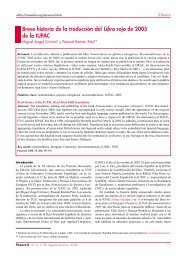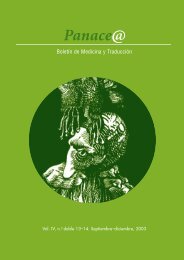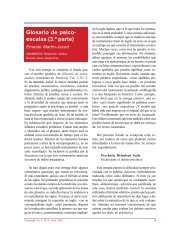You also want an ePaper? Increase the reach of your titles
YUMPU automatically turns print PDFs into web optimized ePapers that Google loves.
Cartas a Panace@<br />
proceeded to kill between 30 and 50 million people worldwide<br />
began among soldiers in the United States in the spring and<br />
summer of 1918. However, it was only in the fall of 1918 that<br />
the influenza produced its “notoriously high lethality” because<br />
it was there it first encountered an environment rich in virulent<br />
possibilities. We are accustomed to think that evolution<br />
is a process glacial in its speed. But give disease the right<br />
conditions, allow it ample channels to pass from immobilized<br />
patients to susceptible surrogates⎯and virulence can increase<br />
exponentially. f More generally, it is worth recalling that until<br />
World War II, “more victims of war died of war-borne microbes<br />
than of battle wounds… [T]he winners of past wars<br />
were not always the armies with the best generals and weapons,<br />
but were often merely those bearing the nastiest germs to<br />
transmit to their enemies.” g<br />
Disease is also promoted by military conquest and empirebuilding.<br />
It may happen, for instance, that war provides the<br />
nexus of conditions propitious for triggering disease. Such<br />
was the case with the Black Death (the bubonic plague) of the<br />
late Middle Ages. The pandemic that was to wipe out between<br />
a quarter and a third of Europe’s total population in just under<br />
five years broke out among the Mongol armies besieging the<br />
Crimean city of Caffa in 1346. While those armies withdrew<br />
sick and in disarray, the plague nonetheless entered Caffa from<br />
whose port it was then dispersed to the Mediterranean and from<br />
there carried to northern and western Europe. Alternatively,<br />
disease can be transferred from one relatively immunized<br />
population to a society whose previous isolation has left it<br />
physically unprepared for pathogenetic collision. It was the<br />
corporeal presence of the Spanish, rather than evil intentions,<br />
that was most responsible for the virtual annihilation of the<br />
Amerindians of Mexico, Peru and Guatemala after 1518. After<br />
smallpox had killed a third of their total population, measles<br />
and other diseases followed. It is estimated that the Mexican<br />
and Peruvian population was diminished by 90 per cent within<br />
120 years. Natives of North America were later similarly<br />
destroyed by the diseases of Europeans (McNeill [1976] 1998:<br />
177, 213; Porter [2002] 2003: 11).<br />
Finally, disease fighting poses complex, and often contradictory,<br />
demands on the state or on its political precursors⎯the<br />
collective actors responsible for organizing, equipping and<br />
waging war. In some circumstances, disease enables a state to<br />
enhance its power and legitimacy. A well-documented case is<br />
the British response to the cholera bacillus in the 1830s and<br />
1840s. Before that time, British authorities were impeded in<br />
their attempt to improve sanitary and other arrangements not<br />
only by the prevalence of the miasmic conception of disease<br />
but also by a powerful “libertarian prejudice against regulations<br />
infringing the individual’s rights to do what he chose<br />
with his own property” (McNeill: 276). Fear of cholera helped<br />
undermine these objections and brought into being such powerful<br />
regulatory bodies as the Central Board of Health. This<br />
in turn strengthened the British state. Equally, the “closer one<br />
gets to eradication” of disease, the more civil liberties are<br />
sacrificed as, for instance, in cases where people’s homes are<br />
compulsorily fumigated or, as in pursuit of the World Health<br />
Organization’s (WHO) “war against smallpox,” individuals<br />
<br />
are forcibly vaccinated (Ewald 2002: 74-5). Coercive quarantine<br />
measures are another example of the state using its muscle<br />
to deprive some of freedom in order to protect the lives of<br />
others.<br />
Conversely, disease can threaten the state by compromising<br />
its ability to fight war⎯ Thucydides remains an insightful<br />
observer of this phenomenon⎯or by eroding its administrative<br />
and material resources, leaving it bereft of authority. This was<br />
the case in Hong Kong during the SARS crisis of 2003 and, to<br />
a lesser extent, in the People’s Republic of China as a whole<br />
(Ma: 2003). Where an epidemic disease is dangerous enough<br />
to require mass emergency response, it takes on the dynamics<br />
of “disasters” more generally. h Another way of putting this<br />
is to say that wars and mass epidemics, like other disasters,<br />
challenge the state’s most basic claim to legitimacy: its claim<br />
to provide social order and to protect citizens from each other<br />
and the depredation of “outsiders.” If provision of security is<br />
the primary raison d’être of the modern state, it follows that<br />
ruling institutions that fail to provide it are likely to become<br />
destabilized. Disease control has also become so integral to the<br />
state’s regulatory capacity that it must increasingly be factored<br />
into its geopolitical considerations and into the international<br />
legal regime. This microbialpolitik, as David Fidler (1999:18-<br />
19, 279-309) calls it, has become urgent with modern communications,<br />
effortlessly transporting diseases around the world,<br />
and with the threat of biological and other weapons of mass<br />
destruction. i<br />
In sum: disease-as-war language does not always stigmatize.<br />
Even as a media frame, it expresses something real and<br />
urgent: the perception that people face the possibility of collective<br />
death. Criticism of this language is no substitute for<br />
grasping its significance for social actors caught-up in extreme<br />
situations.<br />
Notes<br />
a More accurately, diseases like AIDS can be either an individual or a<br />
communal fate, and sometimes both. Hence, to the degree that homosexual<br />
men in the 1970s congregated in the same areas and had<br />
sex with the same partners, one could talk, somewhat loosely, of<br />
AIDS being a community disease. Villages in Africa and Asia that<br />
have since been ravaged by AIDS also show how it can become a<br />
community-wide disaster. Finally, individuals with a disease may<br />
create microcommunities through forming self-help groups or advocacy<br />
organizations.<br />
b See Baehr (2004).<br />
c “The military metaphor in medicine first came into wide use in the<br />
1880s, with the identification of bacterial agents of disease. Bacteria<br />
were said to ‘invade’ or ‘infiltrate’” (Sontag 1990:65-6).<br />
d The quotes come respectively from Manzoni ([1827] 1972:574,<br />
372 Panace@. Vol. VI, n. o 21-22. Septiembre-diciembre, 2005<br />
569).<br />
e By disrupting society, shattering its controls and breaking down its<br />
taboos, war also unleashes revolution, pogrom and “ethnic cleansing”<br />
which kill millions more.<br />
f I am drawing on Ewald 1994: 110-118. On the Great Influenza, see<br />
Barry (2004) and Crosby (1989).<br />
g Diamond 1997:197. Porter ([2002] 2003: 129) remarks that the


